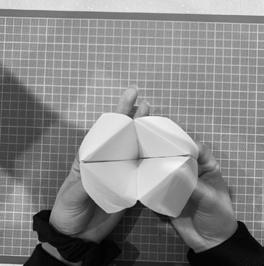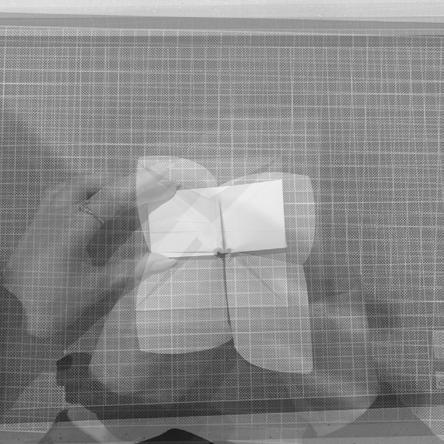
3 minute read
Concept Model Making & Testing
PART I
Model making allows for further experimentation of concepts and other ideas. For this, I combined the two previous case studies from and created a concept model that was fitting. I took the pull and push mechanism of the hoberman sphere and the process of origami to find a concept piece that represents the two.
Advertisement
For my first concept model, I created an origami fortune teller, also known as cootie catcher or chatterbox. I created this using only one piece of square paper, I folded it several times to get the desired object. The origami piece is moveable using your fingers. The motion replicates the hoberman sphere - the push and pull mechanism.
The toy (cootie catcher) is played by children, often written and drawn all over filled with fortunes, secrets and mysteries. The name ‘cootie’ comes from the Malay word ‘kutu’ which means ‘dog tick’. It was then westernised by British soldiers after World War I. It is said that the clamps on the cootie catcher were used to pinch germs up. The origami toy therefore, becomes versatile - purposeful for both children and adults.

It starts off closed, with four fingers meeting in the centre. Then as you pull way vertically in opposite directions, it opens up. Then alternating the movement horizontally (shown in the third image) it opens the other direction. The fortune teller origami can open up further by opening its folded sides. Closed form


Vertically open

Horizontally open
HOW CAN I INCORPORATE THIS IN MY DESIGN?
Firstly, the versatility of the object is a key factor I would like to incorporate into my design. This can implemented through furniture e.g. beds that folds and turns into a desk etc. I also like the playfulness it has, creating fun out of something so simple. I want to utilise this element into my space - creating a fun environment for students.
CONCEPT MODEL MAKING & TESTING
PART I
During my model making process, I captured each stage to identify the movement of my process. The steps of making the origami was also simple and fun.
THE MAKING PROCESS

Combining the processes and analysing the movement at each stage.
Once the origami model was complete, I combined the images of my processes together and traced my movements at each stage. I found that many of the steps were repeated constantly: folding, opening, rotating etc. As you can see from my markings on the image on the left, the movements are repeated. The arrows have a back and fourth motion, they seem to come back to the centre and then move out again. The motions almost becomes a routine - a consistent repetitive movement.
How might this relate to student accommodations & living?
Everyone has a routine they follow that just becomes second nature to us. For most of us we do the same things everyday: we eat, sleep, work and repeat. This is definitely the case nowadays during a pandemic. Social interaction has become limited, therefore also limiting the changes in our routine.
How can I incorporate my findings into my design?
Understanding the movement in my processes and relating that to our everyday routine, has enabled me to question: how can I create an environment that makes these simple, mundane routines more fun and less repetitive. Especially during a pandemic, everything blurs into one. People may have become separated and enclosed in spaces, but these spaces have merged into one. For example, a bedroom where we would sleep, also, becomes a place where we work and eat. I need to challenge these ideas and think of new ways I can adapt spaces so, they can accommodate for all the different uses.










